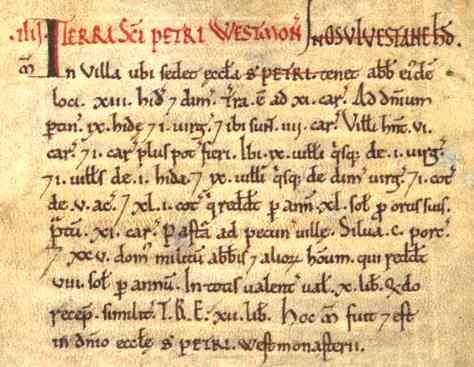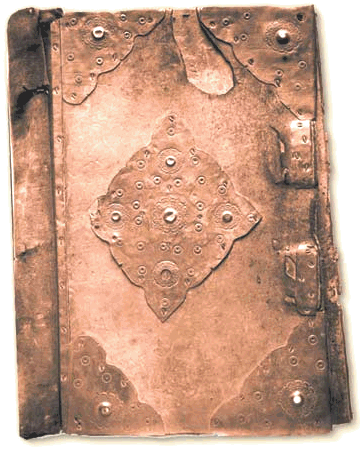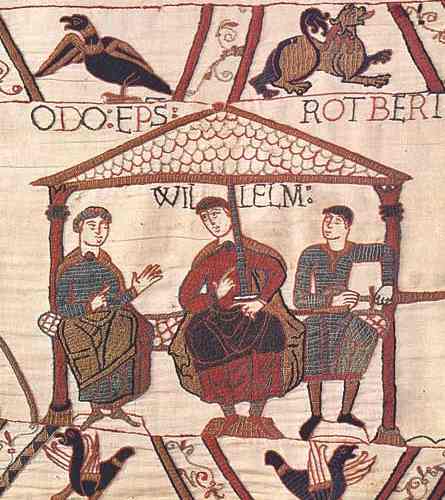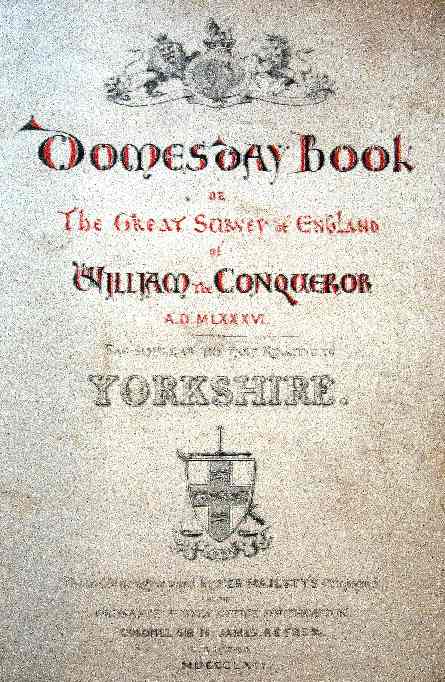|
The Domesday Book (also known as Domesday, or Book of Winchester) was the record of the great survey of England completed in 1086, executed for William I of England.
We
are long overdue for a similar work to document life on the Planet
Earth. The technology and resources are available to be able to
accurately (more accurately than William's Domesday Book) record the
current state of play on Earth.
This
is a potentially important work since if we cannot measure something we
cannot quantify the effect we may be having on other natural resources,
weather patterns and incoming energy.
We are a force of nature and a product of our environment at the same
time, hence our impact on our place of residence can no longer be
ignored, nor the end result if we do not take stock.
Such
a survey would need to take on board other factors, such as the oceans, forests
and ice shelves, each with its vital role
buffering seasonal and orbital changes, which in turn affect life on
Earth.

Nelson
Kruschandl - Wake up Call
We
would thus know how much oxygen is produced, from where and how much
carbon dioxide is made and can be absorbed naturally. This could be
cross referenced with the consumption of natural resources
and the use of these resources for each person as applicable, given
their geographical location and standard of living.
Assuming
allowance is made for each person on Earth to enjoy a minimum standard
of living, which at the moment is not evenly distributed, and if this
can be applied to the territory, as in the ability of the land area to
support life sustainably, we could discover the natural balance for the
Earth and strive to adjust our habits accordingly. If we do not, we will
be fueling the flames
for more disputes and wars, which is
already in progress with oil, even
if we choose to pretend this is not so.
At
the end of the day, our planet can only support so much Human
life, even if properly managed. The important thing to know is how much
Human life is supportable, without upsetting the delicate balance, to
know if we are caught in a spiral of growth that will inevitably exhaust
our resources. At this time we are spending more energy per person than
we can afford. Food for thought. NK
HISTORY
The
Domesday survey was similar to a census by a government of today. William
the Conqueror needed information about the country he had just acquired so he could administer it. While spending Christmas of 1085 in Gloucester, William "had deep speech with his counsellors and sent men all over England to each shire ... to find out ... what or how much each landholder had in land and livestock, and what it was worth." (Anglo-Saxon Chronicle)
One of the main purposes of the survey was to find out who owned what so they could be taxed on it, and the judgment of the assessors was final
- whatever the book said about who owned the property, or what it was worth, was the law, and there was no appeal. It was written in Latin, although there were some vernacular words inserted for native terms with no previous Latin equivalent and the text was highly abbreviated. The name Domesday comes from the Old English word dom, meaning accounting or reckoning. Thus domesday, or doomsday, is literally a day of reckoning, meaning that a lord takes account of what is owed by his subjects. Medieval Christians believed that in the Last Judgment as recorded in Revelation, Christ would carry out a similar accounting of one's deeds—hence the term doomsday also referred to this eschatological
event.
In August 2006, a complete online version of Domesday Book was made available for the first time by the
UK's National Archives.

IIII. The Land of St. Peter of Westminster
In ‘Ossulstone’ Hundred
In the vill in which St. Peter’s Church is situated [Westminster] the abbot of the same
place holds 13½ hides. There is land for 11 ploughs. To the demesne
belongs 9 hides and 1 virgate, and there are 4 ploughs. The villeins have 6
ploughs, and there could be 1 plough more. There are 9 villeins each on 1 virgate
and 1 villein on 1 hide, and 9 villeins on each half a virgate and 1 cottar
on 5 acres, and 41 cottars who pay 40 shillings a year for their gardens. [There is]
Meadow for 11 ploughs, pasture for the livestock of the vill, woodland for 100 pigs,
and 25 houses of the abbot’s knights and other men who pay
8 shillings a year. In all it is worth £10; when
received, the same; TRE £12. This manor belonged and belongs
to the demesne of St. Peter’s Church, Westminster.
Domesday Book
Domesday Book is really two independent works. One, known as Little Domesday, covers Norfolk, Suffolk and Essex. The other, Great Domesday, covers the rest of England, except for lands in the north that would later become Westmorland, Cumberland, Northumberland and County Durham (because some of these lands were under
Scottish control at the time). There are also no surveys of
London, Winchester and some other towns. The omission of these two major cities is probably due to their size and complexity. Cumberland is missing because it was not conquered until some time after the survey and the Prince-Bishop William of St. Carilef had the exclusive right to tax Durham; the omission of the other counties has not been fully explained. Parts of the North East of England were covered by the 1183 'Boldon Book', which listed those areas liable to tax by the Bishop of Durham.
Despite its name, Little Domesday is actually larger — as it is far more detailed, down to numbers of livestock. It has been suggested that Little Domesday represents a first attempt, and that it was found impossible, or at least inconvenient, to complete the work on the same scale for Great Domesday.
For both volumes, the contents of the returns were entirely rearranged and classified according to fiefs, rather than geographically. Instead of appearing under the Hundreds and townships, holdings appear under the names of the local barons, i.e.. those who held the lands directly of the crown in fee.
In each county, the list opened with the holdings of the king himself (which had possibly formed the subject of separate inquiry); then came those of the churchmen and religious houses; next were entered those of the lay tenants-in-chief (barons); and last of all those of women, of the king's serjeants (servientes), of the few English thegns who retained land, and so forth.
In some counties, one or more principal towns formed the subject of a separate section; in some the clamores (disputed titles to land) were similarly treated separately. This principle applies more specially to the larger volume; in the smaller one the system is more confused, the execution less perfect.
Apart from the wholly rural portions, which constitute its bulk, Domesday contains entries of interest concerning most of the towns, which were probably made because of their bearing on the fiscal rights of the crown therein. These include fragments of custumals (older customary agreements), records of the military service due, of markets, mints, and so forth. From the towns, from the counties as wholes, and from many of its ancient Lordships, the crown was entitled to archaic dues in kind, such as
honey.
The information of most general interest found in the great record is that on political, personal, ecclesiastical and social history, which only occurs sporadically and, as it were, by accident. Much of this was used by E. A. Freeman for his work on the Norman Conquest.

The survey
From the Anglo-Saxon Chronicle, it is known that the planning for the survey was conducted in 1085, and from the colophon of the book it is known that the survey was completed in 1086. It is not known when exactly Domesday Book was compiled, but the entire work appears to have been copied out by one person.
Each county was visited by a group of royal officers (legati), who held a public inquiry, probably in the great assembly known as the county court, which was attended by representatives of every township as well as of the local lords. The unit of inquiry was the Hundred (a subdivision of the county, which then was an administrative entity), and the return for each Hundred was sworn to by twelve local jurors, half of them English and half of them Normans.
What is believed to be a full transcript of these original returns is preserved for several of the Cambridgeshire Hundreds, and is of great illustrative importance. The Inquisitio Eliensis, the Exon Domesday (so called from the preservation of the volume at Exeter), which covers Cornwall, Devon, Dorset, Somerset, Wiltshire, and the second volume of Domesday Book, also all contain the full details which the original returns supplied.
Through comparison of what details are recorded in which counties, six "circuits" can be determined.
Berkshire, Hampshire, Kent, Surrey, Sussex
Cornwall, Devon, Dorset, Somerset, Wiltshire (Exeter Domesday)
Bedfordshire, Buckinghamshire, Cambridgeshire, Hertfordshire, Middlesex
Leicestershire, Northamptonshire, Oxfordshire, Staffordshire, Warwickshire
Cheshire, Gloucestershire, Herefordshire, Shropshire, Worcestershire — the Marches
Derbyshire, Huntingdonshire, Lincolnshire, Nottinghamshire, Yorkshire
Purpose
For the object of the survey, we have three sources of information:
The passage in the Anglo-Saxon Chronicle, which tells us why it was ordered:
"After this had the king a large meeting, and very deep consultation with his council, about this land; how it was occupied, and by what sort of men. Then sent he his men over all England into each shire; commissioning them to find out "How many hundreds of hides were in the shire, what land the king himself had, and what stock upon the land; or, what dues he ought to have by the year from the shire." Also he commissioned them to record in writing, "How much land his archbishops had, and his diocesan bishops, and his abbots, and his earls;" and though I may be prolix and tedious, "What, or how much, each man had, who was an occupier of land in England, either in land or in stock, and how much money it were worth." So very narrowly, indeed, did he commission them to trace it out, that there was not one single hide, nor a yard of land, nay, moreover (it is shameful to tell, though he thought it no shame to do it), not even an ox, nor a
cow, nor a swine was there left, that was not set down in his writ. And all the recorded particulars were afterwards brought to him."
The list of questions which the jurors were asked, as preserved in the Inquisitio Eliensis
The contents of Domesday Book and the allied records mentioned above.
Although these can by no means be reconciled in every detail, it is now generally recognized that the primary object of the survey was to ascertain and record the fiscal rights of the king. These were mainly;
-
the national land-tax (geldum), paid on a fixed assessment,
-
certain miscellaneous dues, and
-
the proceeds of the crown lands.

After a great political convulsion such as the Norman conquest, and the wholesale confiscation of landed estates which followed it, it was in William's interest to make sure that the rights of the crown, which he claimed to have inherited, had not suffered in the process. More especially was this the case as his Norman followers were disposed to evade the liabilities of their English predecessors. The successful trial of Odo de Bayeux at Penenden Heath less than a decade after the conquest was one example of the growing discontent at the Norman land-grab that had occurred in the years following the invasion. The survey has since been viewed in the context that William required certainty and a definitive reference point as to property holdings across the nation so that it might be used as evidence in disputes and purported authority for crown
ownership.
The Domesday survey therefore recorded the names of the new holders of lands and the assessments on which their tax was to be paid. But it did more than this; by the king's instructions it endeavoured to make a national valuation list, estimating the annual value of all the land in the country, (1) at the time of Edward the Confessor's death,
when the new owners received it, (3) at the time of the survey, and further, it reckoned, by command, the potential value as well. It is evident that William desired to know the financial resources of his kingdom, and it is probable that he wished to compare them with the existing assessment, which was one of considerable antiquity, though there are traces that it had been occasionally modified. The great bulk of Domesday Book is devoted to the somewhat arid details of the assessment and valuation of rural estates, which were as yet the only important source of national wealth. After stating the assessment of the manor, the record sets forth the amount of arable land, and the number of plough teams (each reckoned at eight oxen) available for working it, with the additional number (if any) that might be employed; then the river-meadows, woodland, pasture, fisheries (i.e. weirs in the streams), water-mills, salt-pans (if by the sea) and other subsidiary sources of revenue; the peasants are enumerated in their several classes; and finally the annual value of the whole, past and present, is roughly estimated.
It is obvious that, both in its values and in its measurements, the survey's reckoning is very crude.
The rearrangement, on a feudal basis, of the original returns enabled the Conqueror and his officers to see with ease the extent of a baron's possessions; but it also had the effect of showing how far he had engaged under-tenants, and who those under-tenants were. This was of great importance to William, not only for military reasons, but also because of his firm resolve to make the under-tenants (though the "men" of their lords) swear allegiance directly to himself. As Domesday Book normally records only the Christian name of an under-tenant, it is not possible to search for the surnames of families claiming a Norman origin; but much has been done, and is still being done, to identify the under-tenants, the great bulk of whom bear foreign Christian names.
To a large extent, it comes down to the king's knowing where he should look when he needed to raise money. It therefore includes sources of income but not sinks of expenditure such as castles; unless their mention is needed to explain discrepancies between pre-and post-Conquest holdings. Typically, this happened in a town, where separately-recorded properties had been demolished to make way for a castle. Also there are the 5'w's who? What? Where? When? Why?

Why
written in Latin
England’s
rulers spoke French, rather than English, at the time when Domesday Book
was written. Latin was the language used for government documents. It
was also the language of the Church. All church services were in Latin
and bibles were also written in Latin. Since the scribe for Domesday
Book was a churchman and it was made for the King's government, it was
written in Latin. Latin was still used for important documents right up
to Victorian times.
The
scribe who wrote Domesday Book also shortened some of the Latin words.
Books were often written in this way, as it saved space. However this
fact makes Domesday Book hard to read. All numbers are written as Roman
numerals.
Subsequent history
Domesday Book was originally preserved in the royal treasury at Winchester (the Norman kings' capital). It was originally referred to as the Book of Winchester, and refers to itself as such in a late edition. When the treasury moved to Westminster, probably under Henry II, the book went with it. In the Dialogus de scaccario (temp. Hen. II.) it is spoken of as a record from the arbitrament of which there was no appeal (from which its popular name of Domesday is said to be derived). In the Middle Ages its evidence was frequently invoked in the law-courts; and even now there are certain cases in which appeal is made to its testimony.
It remained in Westminster until the days of Queen Victoria, being preserved from 1696 onwards in the Chapter House, and only removed in special circumstances, such as when it was sent to Southampton for photozincographic reproduction. Domesday Book was eventually placed in the Public Record Office, London; it can be now seen in a glass case in the museum at The National Archives, Kew which is in the London Borough of Richmond upon Thames in South West London. In 1869 it received a modern binding. Most recently, the two books were rebound for its ninth centenary in 1986, when Great Domesday was divided into two volumes and Little Domesday was divided into three volumes. The ancient Domesday chest, in which it used to be kept, is also preserved in the building at Kew.
The printing of Domesday, in "record type", was begun by the government in 1773, and the book was published, in two volumes, in 1783; in 1811 a volume of indices was added, and in 1816 a supplementary volume, separately indexed, containing:
-
The Exon Domesday — for the south-western counties
-
The Inquisitio Eliensis
-
The Liber Winton — surveys of Winchester early in the 12th century
-
The Boldon Buke — a survey of the bishopric of Durham a century later than Domesday.
Photographic facsimiles of Domesday Book, for each county separately, were published in 1861-1863, also by the government. Today, Domesday Book is available in numerous editions, usually based per county and available with other local history resources.
In 1986, the BBC released the BBC Domesday Project, the results of a project to create a survey to mark the 900th anniversary of the original Domesday Book. In August 2006 the contents of Domesday went on-line, with an English translation of the book's Latin. Visitors to the website will now be able to search a place name, see the index entry made for the manor, town, city or village and, for a fee, download the appropriate page.
Although unique in character and invaluable to the student, scholars are unable to explain portions of its language and of its system. This is partly due to its very early date, which has placed a gulf between Domesday Book and later records which is difficult to bridge.
To the topographer, as to the genealogist, its evidence is of primary importance, as it not only contains the earliest survey of each township or manor, but affords, in the majority of cases, the clue to its subsequent descent.
Bibliography
Domesday Book: A Complete Transliteration. London: Penguin, 2003. ISBN 0-14-143994-7.
Hallam, Elizabeth M. Domesday Book through Nine Centuries. New York: Thames & Hudson, 1986.
Keats-Rohan, Katherine S. B. Domesday People: A Prosopography of Persons Occurring in English Documents, 1066–1166. 2v. Woodbridge, Suffolk: Boydell Press, 1999.
Maitland, F. W. Domesday Book and Beyond. Cambridge: Cambridge University Press, 1988. ISBN 0-521-34918-4
Wood, Michael. The Doomsday Quest: In Search of the Roots of England. London: BBC Books, 2005. ISBN 0-563-52274-7
New
Year's Eve | New
Year's Day | Resolutions
| Peace Message
LINKS

Raise
your expectations for a safer future
......
.......
The World in Your Hands

330ml
alu Earth Can
|





